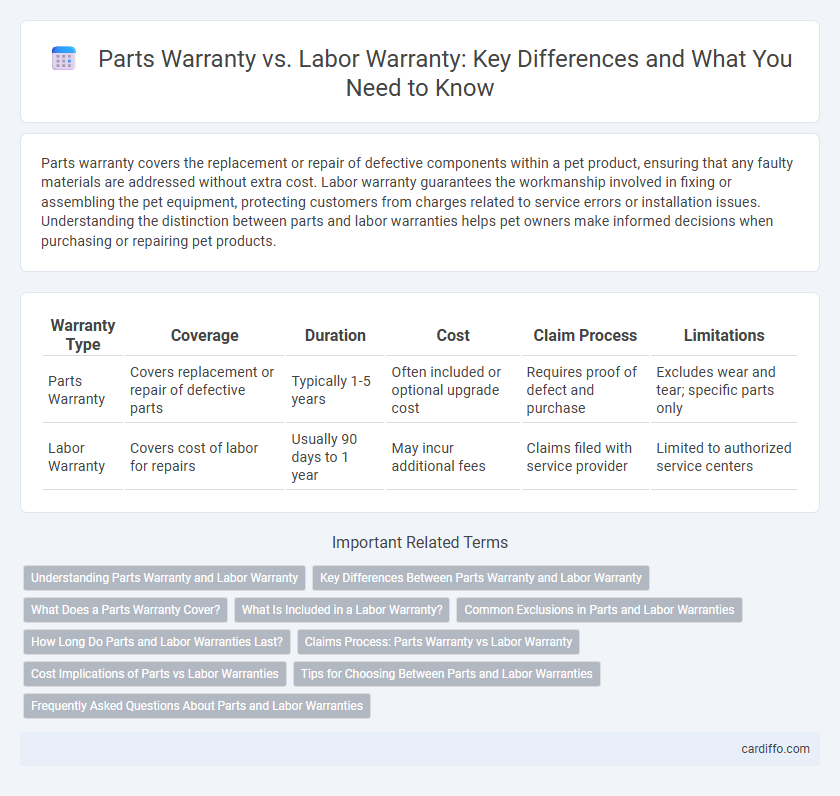Parts warranty covers the replacement or repair of defective components within a pet product, ensuring that any faulty materials are addressed without extra cost. Labor warranty guarantees the workmanship involved in fixing or assembling the pet equipment, protecting customers from charges related to service errors or installation issues. Understanding the distinction between parts and labor warranties helps pet owners make informed decisions when purchasing or repairing pet products.
Table of Comparison
| Warranty Type | Coverage | Duration | Cost | Claim Process | Limitations |
|---|---|---|---|---|---|
| Parts Warranty | Covers replacement or repair of defective parts | Typically 1-5 years | Often included or optional upgrade cost | Requires proof of defect and purchase | Excludes wear and tear; specific parts only |
| Labor Warranty | Covers cost of labor for repairs | Usually 90 days to 1 year | May incur additional fees | Claims filed with service provider | Limited to authorized service centers |
Understanding Parts Warranty and Labor Warranty
Parts warranty covers the replacement or repair of defective components within a specified period, ensuring customers receive original or equivalent parts free of charge. Labor warranty guarantees the quality of workmanship during installation or repair, protecting against defects in service for a defined timeframe. Recognizing the differences between parts and labor warranties helps consumers make informed decisions and seek proper recourse when issues arise.
Key Differences Between Parts Warranty and Labor Warranty
Parts warranty covers the replacement or repair of specific components within a product, ensuring defects in materials or workmanship are addressed. Labor warranty guarantees the cost and quality of the work performed during installation, repair, or maintenance, protecting customers from extra charges for service. Understanding these distinctions helps consumers evaluate overall warranty coverage and anticipate potential costs related to both parts and service labor.
What Does a Parts Warranty Cover?
A parts warranty specifically covers the repair or replacement of defective components within a product for a specified period. It ensures that any malfunctioning parts attributable to manufacturing defects are fixed or replaced at no additional cost to the customer. Labor warranty, in contrast, generally covers the costs associated with the work required to install or repair the parts, but parts warranty itself is limited solely to the parts.
What Is Included in a Labor Warranty?
A labor warranty typically covers the cost of workmanship involved in the repair or installation process, ensuring that the service performed meets quality standards without defects. This warranty does not include replacement parts or materials, which are usually covered separately under a parts warranty. Labor warranty periods vary by provider but commonly range from 30 days to one year, giving customers assurance for the actual repair service quality.
Common Exclusions in Parts and Labor Warranties
Parts warranties typically exclude damage caused by misuse, improper installation, or normal wear and tear, while labor warranties often exclude issues resulting from unauthorized repairs or modifications. Both parts and labor warranties generally do not cover damages arising from environmental factors, such as water damage or corrosion. Understanding these common exclusions is crucial for consumers to avoid unexpected costs and ensure proper maintenance.
How Long Do Parts and Labor Warranties Last?
Parts warranties typically last between 90 days to a year, depending on the manufacturer and product type, while labor warranties often range from 30 days to 90 days. Many extended warranties or service contracts may offer longer coverage on parts, sometimes up to several years, but labor coverage usually remains shorter due to the nature of service work. Always review warranty terms carefully to understand specific timeframes and what is covered under parts versus labor.
Claims Process: Parts Warranty vs Labor Warranty
The claims process for parts warranty typically requires proof of purchase and detailed defect documentation, ensuring the replacement part meets manufacturer guidelines. Labor warranty claims demand clear evidence of workmanship issues, usually verified by authorized technicians before approval. Efficient processing depends on strict adherence to warranty terms, emphasizing timely submission and accurate reporting for both parts and labor.
Cost Implications of Parts vs Labor Warranties
Parts warranties typically cover the cost of replacement components but exclude labor fees, leading to potentially high out-of-pocket expenses for installation or repairs. Labor warranties include the service costs required to fix or replace defective parts, reducing unexpected financial burdens on consumers. Understanding the distinctions helps businesses and customers assess overall cost-effectiveness when selecting warranty plans.
Tips for Choosing Between Parts and Labor Warranties
When selecting between parts and labor warranties, prioritize understanding coverage duration and what each warranty specifically protects--parts warranties cover replacement components, while labor warranties cover the cost of repairs. Assess the reliability of the product's parts and the likelihood of mechanical issues to determine which warranty offers better value. Choose a warranty plan that balances cost with comprehensive protection, ensuring both parts and labor expenses are minimized in potential future repairs.
Frequently Asked Questions About Parts and Labor Warranties
Parts warranty typically covers the replacement or repair of defective components within a specified period, ensuring that faulty parts are addressed without extra cost. Labor warranty guarantees that the workmanship involved in installing or repairing parts will be free from defects for a designated time, covering the service provided by technicians. Common questions often address the duration of each warranty, what damages are included or excluded, and how claims are processed for both parts and labor coverage.
Parts Warranty vs Labor Warranty Infographic

 cardiffo.com
cardiffo.com